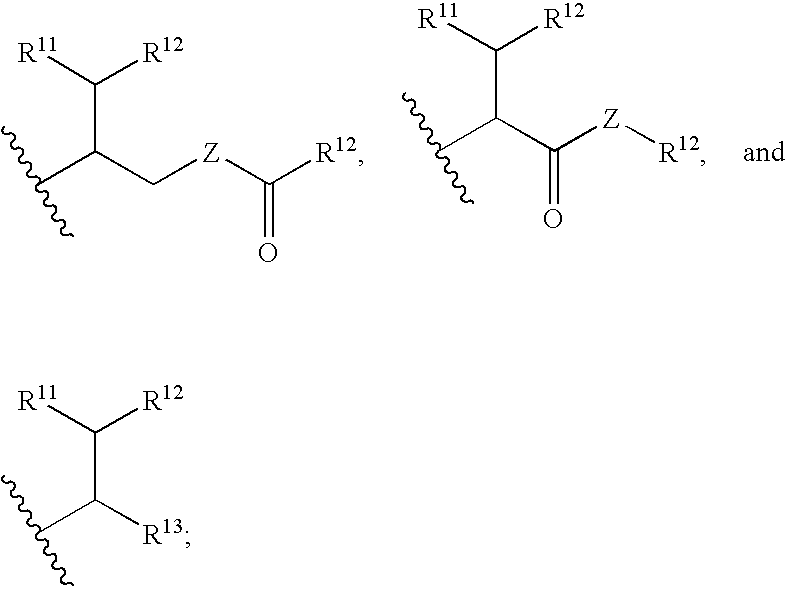Drug conjugates and their use for treating cancer, an autoimmune disease or an infectious disease
a technology of drug conjugates and conjugates, applied in the field of druglinkerligand conjugates and to druglinker compounds, can solve problems such as compromising clinical studies the efficacy of therapeutic effects
- Summary
- Abstract
- Description
- Claims
- Application Information
AI Technical Summary
Benefits of technology
Problems solved by technology
Method used
Image
Examples
example 1
Preparation of Compound 21
[1148]
[1149]Fmoc-(L)-val-(L)-cit-PAB-OH (19)(14.61 g, 24.3 mmol, 1.0 eq., U.S. Pat. No. 6,214,345 to Firestone et al.) was diluted with DMF (120 mL, 0.2 M) and to this solution was added a diethylamine (60 mL). The reaction was monitored by HPLC and found to be complete in 2 h. The reaction mixture was concentrated and the resulting residue was precipitated using ethyl acetate (about 100 mL) under sonication over for 10 min. Ether (200 mL) was added and the precipitate was further sonicated for 5 min. The solution was allowed to stand for 30 min. without stirring and was then filtered and dried under high vacuum to provide Val-cit-PAB-OH, which was used in the next step without further purification. Yield: 8.84 g (96%). Val-cit-PAB-OH (8.0 g, 21 mmol) was diluted with DMF (110 mL) and the resulting solution was treated with MC-OSu (Willner et al., Bioconjugate Chem. 4, 521, 1993, 6.5 g, 21 mmol, 1.0 eq.). Reaction was complete according to HPLC after 2 h. T...
example 2
Preparation of Compound 27
[1151]
[1152]Compound 26 (2.0 g, 2.31 mmol, 1.0 eq.) was diluted with dichloromethane (30 mL), and to the resulting solution was added bis(4-nitrophenyl)carbonate (2.72 g, 8.94 mmol, 3.8 eq.) followed by diisopropylethylamine (1.04 mL, 5.97 mmol, 2.6 eq.). The reaction was complete in 3 d, according to HPLC. The reaction mixture was concentrated and the resulting residue was triturated using ether, then filtered and dried under high vacuum to provide Compound 27 as a yellow solid (2.37 g, 97%).
example 3
Preparation of Compound 28
[1153]
[1154]Fmoc-phe-lys(Mtr)-OH (24) (0.5 g, 0.63 mmol, U.S. Pat. No. 6,214,345 to Firestone et al.) was diluted with dichloromethane to a concentration of 0.5 M and to this solution was added diethylamine in an amount that was approximately one-third of the volume of the Compound 24 / dichloromethane solution. The reaction was allowed to stir and was monitored using HPLC. It was shown to be complete by HPLC in 3 h. The reaction mixture was concentrated in vacuo, and the resulting residue was diluted with ethyl acetate and then reconcentrated. The resulting residue was triturated using ether and filtered. The residual solid was diluted with dichloromethane to a concentration of 0.2M, and to the resulting solution was added MC-OSu (0.20 g, 0.63 mmol, 1.0 eq.) and diisopropylethylamine (0.12 mL, 0.70 mmol, 1.1 eq.). The reaction mixture was allowed to stir under a nitrogen atmosphere for 16 h, after which time HPLC showed very little starting material. The rea...
PUM
 Login to View More
Login to View More Abstract
Description
Claims
Application Information
 Login to View More
Login to View More - R&D
- Intellectual Property
- Life Sciences
- Materials
- Tech Scout
- Unparalleled Data Quality
- Higher Quality Content
- 60% Fewer Hallucinations
Browse by: Latest US Patents, China's latest patents, Technical Efficacy Thesaurus, Application Domain, Technology Topic, Popular Technical Reports.
© 2025 PatSnap. All rights reserved.Legal|Privacy policy|Modern Slavery Act Transparency Statement|Sitemap|About US| Contact US: help@patsnap.com



